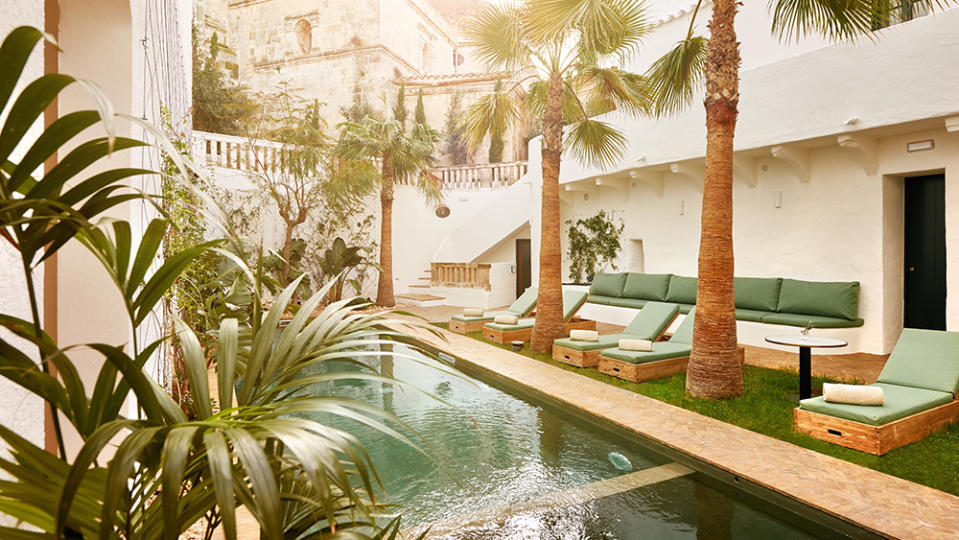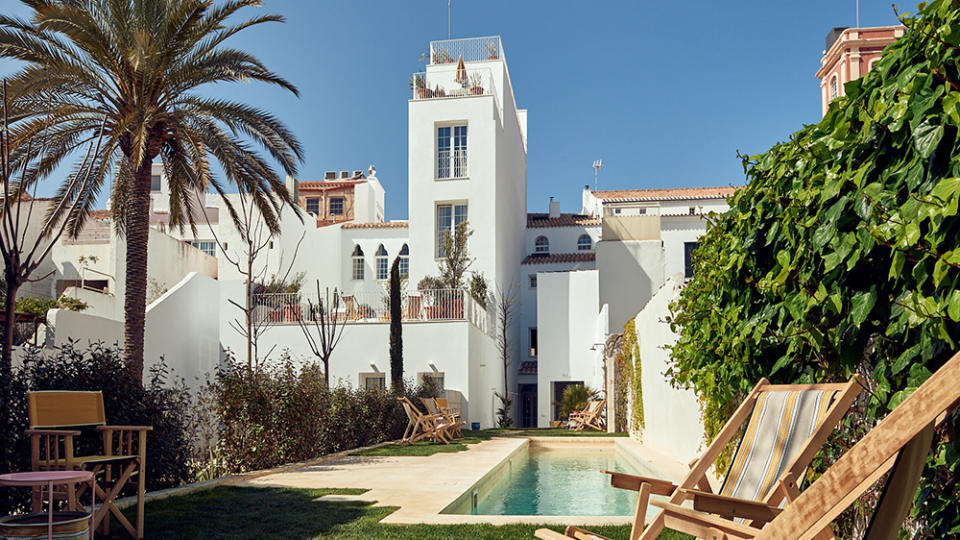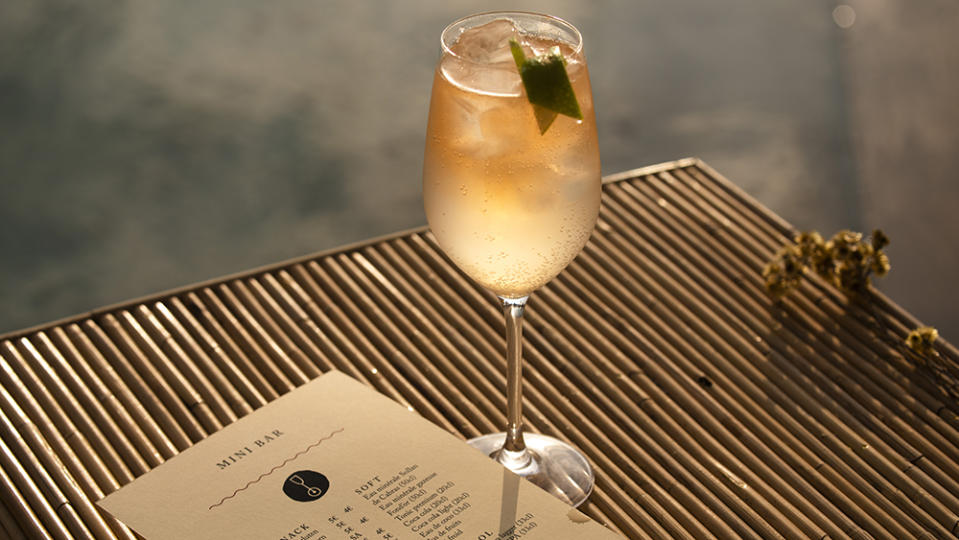Menorca Has Suddenly Become a Summer Hotbed for International Art

“We are in the magic business,” declares gallerist Iwan Wirth, sounding every inch the showman. Today, the works he shows at Hauser & Wirth, the acclaimed art gallery he cofounded with his wife and mother-in-law almost 30 years ago, beguile viewers at outposts in major art capitals, including New York, Los Angeles, London and Hong Kong, as well as places where collectors might spend their downtime, such as Gstaad and the Hamptons. But, arguably, the gallery’s real magic trick is the ability to create a contemporary art scene where you’d least expect one. Which is what has brought me to Isla del Rey, a tiny island inside one of the world’s largest natural harbors, at Mahón on the Spanish Balearic island of Menorca.
Here, in a former naval hospital’s barracks and outbuildings reachable by a short ferry ride from Mahón, Hauser & Wirth will unveil its latest project: an art center with 11,300 square feet of exhibition space and an outdoor sculpture trail, along with a restaurant, a shop and a garden with indigenous flowers planted by Piet Oudolf of High Line fame. One of Louise Bourgeois’s signature giant spiders now reigns over the patio, an abstract piece from the Spanish Basque sculptor Eduardo Chillida stands in a small grove overlooking the harbor, and staff are readying the inaugural exhibition, a group of paintings and sculptures by the celebrated LA-based artist Mark Bradford. With Hauser & Wirth Menorca’s summer opening, the low-key Balearic is poised to take on a new, higher profile and an influx of taste-making visitors.
More from Robb Report
These Long-Lost Fragonard Paintings Were Missing for Centuries. France Just Bought Them Back.
This Spanish Music Fest Is Converting Old Jumbo Jet Fuselage Into a Stage and Dance Floor
How a Former Pro Rugby Star Found a Second Calling as a World-Renowned Winemaker
As we’re well aware, where the art crowd goes, the fashionable hotels, restaurants, bars and shops aren’t far behind, and the real-estate market quickly kicks into high gear. Gallerists and artists know a sweet spot when they see it—or they know how to create one—and Menorca surely qualifies. With buzz for Hauser & Wirth Menorca building over the past few years, the hospitality industry has taken note. As Pablo Carrington, the hotelier behind the island’s Torralbenc, puts it, “The gallery is undoubtedly going to be a huge drawcard, shining a light on the rest of the island and all its treasures that are currently somewhat under the radar.”

Be Creative
Menorca, with an eco-friendly, youthful vibe, has never had the following of Ibiza, the Balearic known for its hedonistic party scene, or even of Mallorca, the elegant member of the archipelago where the Swiss-born Wirth and his wife, Manuela, long summered with her mother, Ursula Hauser. Paris-based architect Luis Laplace, a frequent collaborator of theirs, also had a house there.
Several years ago, the Wirths began thinking about finding a summer home of their own and tasked Laplace to look for real estate. They zeroed in on Menorca. “Luis [did] a deep dive into the island, in a completely private capacity for us,” says Iwan, who fell in love with it though he’d never spent more than a day there at a time. “We then visited the island with completely different eyes. That’s about five years ago now.”
Like client, like architect. The Wirths and Laplace both bought Menorcan farmhouses. “I love all the islands—the posh one, the naughty one,” Laplace says. “And here, it’s paradise.”
Soon enough Iwan’s plans, as they’re wont to do, included art. Curious about Isla del Rey, he inquired about its buildings. Laplace then met Luis Alejandre, president of the community-led Isla del Rey Foundation, whose volunteers have been giving up their weekends since 2005 to restore the hitherto abandoned base. Both sides could envision the tiny dot in the Mediterranean becoming another Somerset, England, where Hauser & Wirth had defied convention by opening a space on the outskirts of an off-the-beaten-path town called Bruton in 2014. The Wirths invited Alejandre, along with a delegation of his fellow volunteers and local officials, to see it firsthand. “Visiting Bruton is one of the best decisions we took,” says Alejandre. “Without being experts in contemporary art, we saw the model of a project which could be integrated on the island, together with our initiative,” which includes a museum of medicine in the 18th-century hospital.

Hotel Torralbenc
Somerset is where the Wirths first hit upon the formula of combining spectacular art—the gallery’s roster includes Cindy Sherman and Glenn Ligon, among a galaxy of stars—with a beautiful setting, heritage buildings reimagined by Laplace, a farm-to-table restaurant and an eye to the broader community. For Iwan, “the magic of a place” plus good food and wine are “our Trojan horse,” sugaring the pill of contemporary art, which, he acknowledges, can often be “challenging.”
But key to Somerset’s success has been the bond the gallery has forged with the area’s residents through a combination of the Wirths’ undoubted charm and social programs championed by Manuela, a former school teacher, which include tuition-free art classes for local children. The Wirths are determined to create a community gallery, not an alien, art-world entity landing like a spaceship. The Swiss-born couple even assimilated into the rural English culture, selling their West London house (to the Beckhams) and moving their family to Somerset, where they now live on an organic farm that supplies the gallery’s restaurant.
They imported the approach to Menorca, where Laplace again restored derelict structures and the gallery is working in tandem with the community. Bradford is even creating a mural with local art students. Hauser & Wirth’s Menorcan-born director, Mar Rescalvo Pons, describes the collaboration between the gallery and the foundation as “an exchange.” “We are putting Mahón on the contemporary art map,” she says, “while we benefit from their knowledge and experience.”
A certain kind of wholesome simplicity could be said to be part of Menorca’s brand positioning, given that the island gained UNESCO Biosphere reserve status in 1993, which means that caring for both Menorca’s environment and the well-being of its people informs all official decision-making. Thus Laplace’s blueprint for the gallery’s patio and restaurant, Cantina, includes grooves for the little lizards that are unique to Isla del Rey to scurry along and spaces for them to hide in, while many of the island’s new hotels and restaurants stress their sustainable credentials and the local provenance of their food and wine.
Menorca’s history and prehistory—there are archaeological sites all over the island from the distinct Talayotic civilization, which flourished here before the Romans conquered the island—are also a major draw. After the Romans came the Moors, who would be brutally expelled in 1287 by Alfonso III of Aragon, after whom Isla del Rey, or King’s Island, is named because it was where he first stepped foot on Menorcan land before launching his attack. Menorca eventually became part of the unified Spanish kingdom before Britain claimed it in the 18th century. British influence is still visible in Mahón, where Georgian-style sash windows punctuate many of the handsome merchants’ townhouses and where imported words survive in the Menorquín dialect of Catalan, such as bòtil, greví and boinder (bow window). You can even taste the British influence: The occupiers shipped over Friesian cows, and today much of the agriculture is dairy-based, producing the famous queso de Mahón. And the local gin is excellent.

Karel Balas
France and Spain squabbled with the British over Menorca for some time before the island ultimately rejoined Spain in 1802. The next conquest didn’t come until the very end of the Spanish Civil War, in 1939, when the island was one of the last Republican strongholds to fall to General Franco’s Nationalists. But the generalissimo’s long-held grudge against Menorca arguably saved it from the worst of the rapid development that marred the country’s coastlines when they were opened up to mass foreign tourism in the 1960s and ’70s and Franco showered development funds on nearby Mallorca and Ibiza.
“The island’s appeal is simplicity—it is very, very unpretentious. For me that’s the real luxury,” says Laplace, citing the simple waterfront vermouth bar, Can Vermut, close to where water taxis (soon to be joined by a shuttle) ferry visitors to and from the gallery, as a favorite of his and the Hauser & Wirth team. What’s more, “it’s never really crowded here,” he adds, and unlike Ibiza and Mallorca in high season, “there are never any traffic jams.”
For Pons, the director, one pleasure of being back on the island is the wonderful feeling of swimming in the sea after the day’s work is done and in the evening heading to the restaurant El Mirador, with its view over Mahón harbor.
The Wirths’ routine while staying on the island includes shopping for fish at Mahón’s fish market or heading to Antics Antigüedades to look for antique furniture. Manuela recommends S’Amarador in Ciutadella “for great views to the harbor and delicious paellas,” and likes going to the opera at Teatro Principal in Mahón, the oldest opera house in Spain (for which Bradford has designed the poster for the 2021 season). The couple enjoy eating caldereta de langosta at Sa Llagosta at the old fishermen’s harbor in Fornells, a village on the north end of the island (though traditionalists might favor the cooking at Es Cranc). That Menorcans take lobster—a classic plutocratic ingredient—and turn it into a relatively homely but delicious stew seems axiomatic of the island. But that’s what wealthy Barcelonans come for when they sail to Fornells (perhaps with a glass of the Menorcan Xoriguer gin and tonic to start). Likewise the former monarch Juan Carlos, who in the 1980s and ’90s took to sailing over to Fornells from the royal summer home in Mallorca (well before he abdicated and later hightailed it to Abu Dhabi).

Daniel Schaefer
My guide on a whirlwind swing around the island, Isabel Martin, tells the story of an American visitor who arrived at Mahón on a superyacht and wanted a quick tour. “I took him to the usual places,” she explains. To Monte Toro, the highest point, where you can see most of the island, including the almost entirely undeveloped north coast. Here there are secluded beaches reachable only by boat or by foot, perhaps on the restored ancient Camí de Cavalls bridle paths. She showed him S’Albufera des Grau national park and some of the hundreds of prehistoric monuments on the island. But what the visitor was most charmed by were the distinctive olive wood gates that, along with dry stone walls, can be seen throughout Menorca—and what thrilled him was when she quickly customized the tour to include a workshop where he could see them being made, exactly as they always have been. “He just loved that.”
A determined authenticity remains central to the appeal of Menorca, which, while it doesn’t have Mallorca’s starry enclaves or Ibiza’s manic nightlife, has a burgeoning upscale hospitality scene. The town of Ciutadella already feels relatively swanky. If Mahón’s townhouses, bastions and naval installations proclaim its mercantile and military past, Ciutadella’s history as the former capital and the home of Menorca’s aristocracy is evident in its grand palaces, including one that forms the Can Faustino boutique hotel. In normal times there is a famous fiesta here every June, in which expert riders caracole their magnificent but gentle, perfectly trained Menorcan horses through the streets on their hind legs. Crowds hover perilously close to their hooves to stroke the horses’ hearts for luck, or applaud wildly as the aristocratic jockeys ride them dashingly in and out of palaces.

Daniel Schaefer
Meanwhile, some of Mahón’s old townhouses have become boutique hotels and upscale B&Bs—making up in charm what they might lack in well-stocked minibars or top-grade Wi-Fi. Of these, the first and possibly the finest is Can Albertí, its décor a pleasing mix of Menorcan antiques and contemporary art. Several good hoteles rurales have opened up in the interior, many of them French-owned. For in the words of one longstanding English resident, “the French are snapping up everything.” Premium residential real-estate agency Engels & Völkers reported that French buyers now represent 50 percent of its Menorcan sales. “But they are doing some interesting things here,” the Englishwoman adds. That might mean transforming humble fincas, or farms, into things of beauty—perhaps with their own hydroponic farming—as well as smart hotels such as the excellent and buzzy Menorca Experimental and Fontenille. As Can Faustino’s concierge points out, if exaggerating a bit, “Mahón is just a 90-minute direct flight from Paris—what could be easier?”
But for Herve Durochat, who cofounded several successful restaurants in London before moving here last year to launch several new projects, including his harborside Arlette restaurant in Mahón and a soon-to-open tapas bar, Agustin, the events of the last year have made him “realize that it was time for a change and to enjoy life better,” he says. “We love the sea, the country life and nature. So Menorca ticks all the boxes.” And that’s even without the art.
The Essentials
Where to Stay
Mahón has several good boutique hotels in handsomely restored townhouses. Can Albertí, the pioneer, has 15 rooms and suites decorated with a mix of contemporary art and antiques, chosen with exquisite taste—and in the perfect location, just opposite the faded Georgian splendor of the former governor’s mansion. The rooftop patio gets the sea breeze even on the hottest of days. Opened by local architects in their former offices, Jardí de Ses Bruixes also combines antique furniture with contemporary paintings. There’s a small restaurant on the shady back patio, overlooked by a stunning art nouveau salon. Cozy but elegant, Cristine Bedfor is the latest boutique offering—complete with a swimming pool—but is unlikely to be the last.
At the other end of the island in Ciutadella, the former capital, an aristocratic palace has been transformed into Can Faustino, the first Relais & Châteaux property in Menorca. From the upper floors of the building, guests can look beyond the hotel’s garden restaurant and pool toward the city’s harbor— and on a clear day, Mallorca on the horizon.
In the countryside, Menorca Experimental forms an interesting contrast with Torralbenc. The first offers agroturismo hospitality at its finest, with superb food, an ambitious wine list, a spa—and a playful party vibe. There is no beach, but the cliff-top yoga platform offers a beautiful view of the water. At Torralbenc, home of one of Menorca’s leading wineries, a more old-school hush prevails. Use the buzzer beside your poolside lounger to order a glass of Ruinart or sangría before a fine-dining supper you may want to dress up for. For a dip in the sea, the excellent beach at Cala’n Porter is five minutes’ drive away. Also recommended: Binigaus Vell, one of Menorca’s first rural hotels, is close to a good beach, while Fontenille Menorca is a well-run French hotel (now also with Relais & Châteaux) consisting of two former farmhouses a few miles apart.
Where to Eat/Drink

Karel Balas
El Romero is a fine sustainable-fish restaurant on Mahón’s Plaza de la Conquista with an innovative menu and interesting wine list, including Torralbenc Malvasia and Sa Cudia, Menorcan white wines made entirely from Malvasia grapes. Arlette, on the harbor near where many superyachts moor, serves excellent French-influenced Mediterranean cuisine. Menorca Experimental is well worth a visit for the Menorcan-French fusion food and a wine list composed mostly of small French and Spanish winemakers. Can Vermut makes great tapas, likewise the tapas outlets that now occupy half of Mahón’s fish market. For a Menorcan gin and tonic savored with views of Mahón harbor, head to El Mirador, while there are high hopes for the soon-to-reopen American Bar, a longstanding institution taken over by Binifadet, which also provides the food and wine for Hauser & Wirth’s Cantina on Isla del Rey.
Best of Robb Report
The 7 Most Insanely Luxurious Spas in the World, From Tokyo to Iceland
17 Reasons the Caribbean Should Be at the Top of Your Travel Itinerary
Sign up for Robb Report's Newsletter. For the latest news, follow us on Facebook, Twitter, and Instagram.

